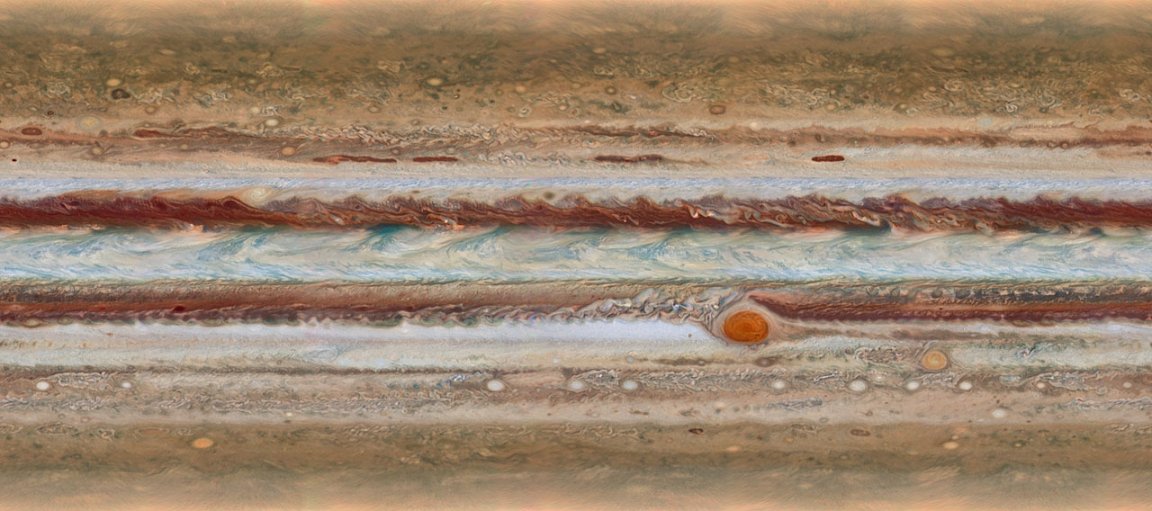
Jupiter is known for many things, from its huge size to its 60-some exotic moons, but its Great Red Spot is inarguably one of its grandest features. Unfortunately, NASA revealed last year that Jupiter’s Great Spot is shrinking so drastically, it could completely disappear in a few short years.
First made note of by Giovanni Cassini (yes, the guy the Cassini mission to Saturn was named after), the Great Red Spot is a colossal storm that has been brewing in Jupiter’s upper-atmosphere for at least 400 years—though no one knows exactly how long it has been around, or exactly how it formed in the first place. Thanks to images and measurements taken by Hubble and space-based probes, we know that the storm’s red hue comes from an assortment of complex organic molecules: like sulfur and red phosphorus.
Following the Trends:
Of course, the vortex itself has changed a lot over the years. The first measurement—gathered in the late 1800’s— suggested the storm was 25,476 miles (41,000 km) wide. Measurements taken in the intervening years show it has halved in size, and it continues to dwindle.
To be more precise, when Voyager 1 and 2 passed by in 1979, they measured the storm to be 14,500 miles (23,335 km) across. In 1995, Hubble revealed the storm was around 1,000 miles (1,609 km) smaller—going from 14,500 miles (23,335 km) to 13,020 miles (20,954 km). Then, just 14 years later, it was down to 11,130 miles (17,912 km).
Finally, in 2014, images revealed that the storm has dwindled so much, the spot isn’t so much an oval anymore, more like an circle—extending just 10,250 miles (16,100 km) across. Such measurements suggest that the storm is shrinking 621 miles (1,000 km) per year.
The Not-So-Great Red Spot:
The latest images from the Hubble Space Telescope further chart the decline of Jupiter’s Great Red Spot—seemingly painting the bleakest picture yet of the famous storm, but it isn’t all bad. In fact, the images themselves are rather stunning.
Taken using Hubble’s Wide Field Camera 3 over the course of ten hours, astronomers used the data to put together detailed maps of the entire Jovian planet—revealing an array of features, ranging from clouds to storms. By studying them, astronomers can glean insight into things like wind speeds and other atmospheric changes happening within Jupiter’s outer layers.
Namely, the images provide more confirmation that the storm is shrinking gradually, but fortunately, the rate at which it declines appears to have slowed down slightly. Between the last viewing and this one, it is merely 149 miles (240 km) smaller.
According to NASA/ESA:
The spot’s size is not the only change that has been captured by Hubble. At the center of the spot, which is less intense in color than it once was, an unusual wispy filament can be seen spanning almost the entire width of the vortex. This filamentary streamer rotates and twists throughout the ten-hour span of the Great Red Spot image sequence, distorted by winds that are blowing at 334 miles (540 km) per hour.
There is another feature of interest in this new view of our giant neighbor. Just north of the planet’s equator, researchers have found a rare wave structure, of a type that has been spotted on the planet only once before, decades ago by the Voyager 2 mission, which was launched in 1977. In the Voyager 2 images the wave was barely visible and astronomers began to think its appearance was a fluke, as nothing like it has been seen since, until now.
The current wave was found in a region dotted with cyclones and anticyclones. Similar waves—called baroclinic waves—sometimes appear in the Earth’s atmosphere where cyclones are forming. The wave may originate in a clear layer beneath the clouds, only becoming visible when it propagates up into the cloud deck, according to the researchers.
[Reference: Space Telescope]
These maps are just the first in a series that will touch base on all of the other planets in our solar system. Called the Outer Planet Atmospheres Legacy program (or OPAL), astronomers hope they will help us better understand rarely visited worlds like Neptune and Uranus, which have already been observed by Hubble through the program. Once those maps are released, Hubble will turn its attention to Saturn.
Ultimately, the maps won’t just shed light on the atmospheric conditions of worlds on the other end of our solar system, but our own planet as well. Maybe they could even benefit us where planets many light-years away from our solar neighborhood are concerned.